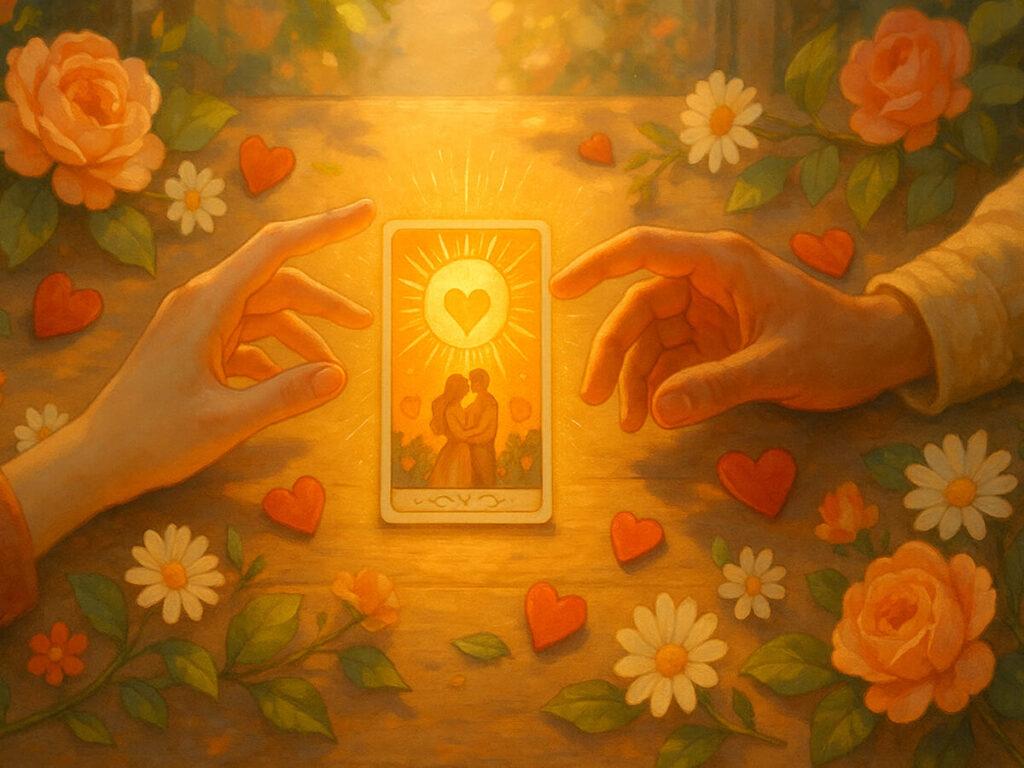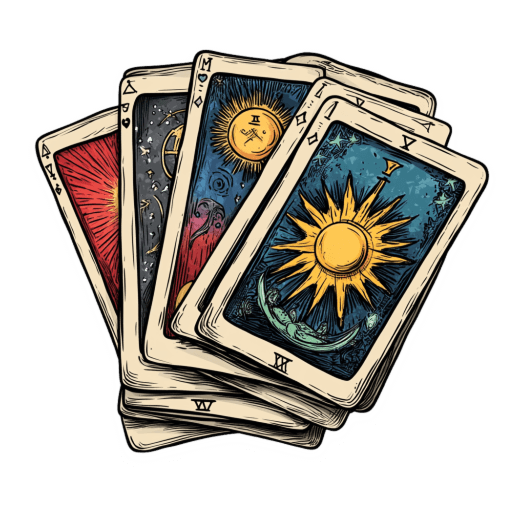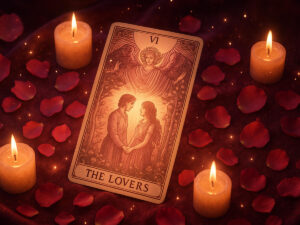5 Powerful Tarot Spreads to Understand Your Relationship


Table of Contents
Hey there, lovely souls! Let’s talk about something near and dear to many of our hearts: relationships. And let’s talk about a tool that, honestly, sometimes gets a bit of a mystical, maybe even intimidating, rap – tarot cards. You might picture a dimly lit room, a crystal ball, someone predicting doom and gloom… but can I let you in on a little secret? Tarot is so much more than just fortune-telling, especially when it comes to understanding the connections we share with others.
I remember when I first picked up a tarot deck. I was curious, maybe a little skeptical, and definitely looking for answers about my own confusing love life. What I discovered wasn’t a magic eight ball spitting out yes/no answers, but something far more profound. Tarot became like a wise, non-judgmental friend, a mirror reflecting back the energies, patterns, and possibilities I couldn’t quite see on my own. It’s a tool for insight, for self- reflection, for digging deep into the heart of the matter – literally!
So, how does this deck of 78 cards actually help with relationships? Well, think about it. Relationships are complex, right? Full of unspoken feelings, hidden dynamics, past baggage, future hopes… it’s a lot! Tarot cards, with their rich symbolism and archetypal stories, provide a unique language to explore all of that. They can help you:
- Gain Perspective: Sometimes you’re too close to a situation to see it clearly. A relationship tarot spread can offer a bird’s-eye view, showing you the underlying dynamics, the roles you and your partner (or potential partner!) are playing, and the energy flowing between you.
- Understand Emotions: Both yours and theirs! Cards can highlight the emotional currents at play – are there feelings of joy, insecurity, passion, fear? Understanding the emotional landscape is crucial for navigating any relationship.
- Identify Challenges & Opportunities: No relationship is perfect. Tarot can gently point out potential roadblocks, communication issues, or conflicting desires. But it also shines a light on the strengths, the shared values, and the opportunities for growth and deeper connection.
- Empower Self-Understanding: This is huge! Often, the most valuable insights from a relationship reading are about you. How are you showing up? What patterns are you repeating? What do you truly need and desire? Tarot helps you understand your own heart better, which is fundamental to building healthy connections.
Especially if you’re new to tarot or seeking advice on navigating the sometimes-choppy waters of love, these cards can be incredibly grounding. They don’t dictate your future; they empower you with awareness. They offer guidance, highlight possibilities, and encourage you to make conscious choices. Think of tarot not as predicting your romantic destiny, but as illuminating the path you’re currently on, helping you understand the journey and maybe, just maybe, steer it towards a more fulfilling destination. Ready to explore how? Let’s dive in!
Getting Started: Preparing for a Relationship Reading
Okay, so you’re intrigued, maybe even excited, about using tarot for your relationship questions. Awesome! But before you just grab a deck and start flipping cards, let’s talk prep. Trust me, a little intention-setting goes a long way in making your readings clearer and more meaningful. It’s like cooking – you wouldn’t just throw random ingredients in a pot, right? Same idea here.
First things first, the deck! If you’re new, the sheer variety of tarot decks can feel overwhelming. My advice? Don’t overthink it too much. Look at images online or in a local shop if you can. Which artwork speaks to you? Which one feels inviting or intriguing? Some beginners love the classic Rider-Waite-Smith deck because tons of resources use its imagery. Others prefer modern, minimalist, or themed decks. Honestly, the “best” deck is the one you feel a connection with. I remember spending ages choosing my first deck, and finally landing on one simply because the colors felt calming. Go with your gut!
Next up: setting the mood. You don’t need candles and incense (unless that’s your vibe!), but finding a quiet moment and space where you won’t be interrupted is key. Turn off the TV, silence your phone – give yourself permission to focus. Take a few deep breaths. The goal is to clear your mind a bit and approach the reading with openness, not frantic energy. I often just find a comfy corner, maybe make a cup of tea, and take a minute to just be before I shuffle.
Now, the crucial part: your question. This trips up a lot of beginners! Avoid simple yes/no questions like “Does he love me?” or “Will we get back together?”. Tarot works best with open-ended questions that invite exploration and guidance. Think about what you really want to understand. Instead of “Does he love me?”, try:
- “What is the nature of the connection between us right now?”
- “What energy am I bringing to this relationship?”
- “What do I need to understand about my partner’s perspective?”
- “How can I foster better communication in this situation?”
- “What lesson can I learn from this relationship experience?”
See the difference? These questions open doors for insight, rather than demanding a simple, often unhelpful, answer. Focus your question clearly in your mind as you move to the next step.
Shuffling! There’s no single “right” way. Some people riffle shuffle like playing cards (carefully!), others prefer a more gentle overhand shuffle, and some just spread the cards out and mix them around. Do what feels comfortable. The important thing is the intention. As you shuffle, keep your question in mind. Pour your energy, your query, into the cards. Keep shuffling until it feels “right” to stop – again, trust that little intuitive nudge.
Then, it’s time to draw your cards for the specific relationship tarot spread you’ve chosen (we’ll get to those next!). Lay them out in the designated positions. And remember, while learning the traditional meanings of the cards is super helpful (and there are tons of great books and websites for that!), don’t discount your intuition. What immediate feelings or thoughts pop up when you see a card? What does the imagery suggest to you in the context of your question? Sometimes, your gut reaction holds the most personal and powerful message. Let’s get ready to explore some simple spreads!
Simple Relationship Tarot Spreads for Beginners
Alright, you’ve got your deck, you’ve set the mood, you’ve got your question – now for the fun part: laying out the cards! A “tarot spread” is simply a specific pattern or layout for your cards. Each position in the spread represents a different aspect of your question, giving structure and focus to the reading. Think of it like a map for exploring your query.
For beginners, especially when delving into the complexities of relationships, starting simple is often best. You don’t need a massive, complicated spread to get meaningful insights. Here are a couple of my favorite go-to simple relationship tarot spreads that are perfect when you’re just starting out:
The One-Card Pull: Your Daily Dose of Insight
This is the simplest spread of all, but don’t underestimate its power! It’s fantastic for a quick daily check-in on the energy surrounding your love life or a specific relationship question.
- How to do it: After shuffling with your question in mind (e.g., “What energy should I focus on in my relationship today?” or “What’s the core theme of my connection with X right now?”), simply draw one card.
- Interpretation: This single card offers a snapshot, a central theme, or a piece of advice. For example, pulling The Lovers might suggest harmony, choice, or alignment. Pulling the Five of Swords could indicate conflict or a need to pick your battles. Pulling the Two of Cups might point to partnership and mutual affection.
- Why it’s great for beginners: It’s quick, easy to focus on, and helps you build familiarity with individual card meanings in a relationship context without feeling overwhelmed.
The Three-Card Spread (Past-Present-Future): The Narrative Flow
This is a classic for a reason! It provides a simple yet insightful narrative about a situation.
- How to do it: Draw three cards and lay them out from left to right.
- Card 1 (Left): The Past. What past experiences, energies, or events are influencing the current situation? What foundation was laid?
- Card 2 (Middle): The Present. What is the current energy or state of the relationship/situation? What’s happening right now?
- Card 3 (Right): The Potential Future. Where is the situation likely heading if things continue on their current path? What’s the potential outcome or advice for moving forward?
- Example: Asking about a budding romance, you might get the Ten of Swords (Past painful ending of a previous relationship), the Two of Cups (Present – mutual attraction, partnership forming), and the Four of Wands (Future – potential for stability, celebration, harmony).
- Why it’s great for beginners: It gives a clear sense of progression and helps you see how past influences shape the present and potential future.
The Three-Card Spread (You-Partner-Relationship): The Dynamic Snapshot
This variation focuses specifically on the interplay between two people.
- How to do it: Draw three cards. You can lay them in a line or a small triangle.
- Card 1: You. Represents your energy, perspective, role, or contribution to the relationship.
- Card 2: Your Partner/Other Person. Represents their energy, perspective, role, or contribution.
- Card 3: The Relationship. Represents the dynamic between you, the core energy of the connection, or the potential synthesis of your energies.
- Example: Asking about communication issues, you might get the Queen of Swords (You – seeking clarity, perhaps being a bit guarded), the Knight of Cups (Partner – offering emotions, perhaps being less direct), and The Tower reversed (Relationship – avoiding necessary upheaval, resisting change).
- Why it’s great for beginners: It directly addresses the interpersonal dynamics and helps you understand different perspectives within the connection.
Deeper Insights: Exploring More Complex Spreads
So, you’ve been playing around with the one-card pulls and three-card spreads, and you’re starting to get the hang of it. Maybe you’re feeling ready to dig a little deeper, to ask more nuanced questions, or to explore specific facets of your relationship in more detail. That’s awesome! When you feel that pull to understand more, that’s often a sign you’re ready to explore slightly more complex relationship tarot spreads.
Don’t let the word “complex” scare you off! It just means these spreads involve a few more cards, allowing for a more layered and detailed reading. They take a bit more practice to interpret, sure, but the richness of the insights they offer can be totally worth it.
Here are a couple of popular options that build beautifully on the simpler spreads:
The Five-Card Cross Spread: Adding Layers
Think of this as an expansion of the three-card spread. It adds context and depth, often looking at the foundation and potential future or challenges and strengths.
- How it often works: There are variations, but a common one builds on the “You- Partner-Relationship” idea. You might lay out cards like this:
- You: Your energy/role.
- Partner: Their energy/role.
- Past Foundation: What brought you together or underlies the current situation?
- Present Status/Challenge: What the core dynamic or main obstacle right now?
- Potential Future/Outcome: Where is this heading based on current energies? (Another variation might replace Past/Future with Challenge/Potential or Strengths/Weaknesses)
- What it offers: This spread gives you more context. Seeing the past foundation alongside the present challenge and future potential can be really illuminating. It helps you understand how you got here and where ‘here’ might lead.
- Beginner Tip: Focus on how the ‘Past’ card informs the ‘Present’ card, and how the ‘You’ and ‘Partner’ cards contribute to the overall dynamic shown in the ‘Present’ and ‘Future’ cards.
The Compatibility Spread (5 or 7 Cards): How Do We Align?
This spread is fantastic when you want to specifically explore how well you and a partner (or potential partner) mesh on different levels. It moves beyond just the overall dynamic to look at specific areas of connection.
- How it often works (7-card example):
- Your Wants/Needs: What are you looking for in this connection?
- Partner’s Wants/Needs: What are they looking for?
- Similarities/Strengths: Where do you align? What brings you together?
- Differences/Challenges: Where might friction or disagreement arise?
- Emotional Compatibility: How do your emotional worlds connect?
- Physical Compatibility: What’s the energy around your physical connection?
- Mental Compatibility: How do you connect intellectually or in communication? (A 5-card version might combine the compatibility aspects into one ‘Potential’ card or omit some positions).
- What it offers: This gives a really detailed look at the different facets of compatibility. It can highlight where your strengths lie as a couple and where you might need to put in more effort, understanding, or compromise.
- Beginner Tip: Don’t get bogged down if one area seems ‘bad’. Look at the whole picture. Strong mental connection might balance weaker emotional alignment, or vice versa. It’s about understanding the whole dynamic.
Beyond These
As you explore, you’ll find tons of other spreads out there! Some focus specifically on finding a soulmate (“Soulmate Spread”), understanding conflicts (“Relationship Challenges Spread”), or making decisions (“Path A/Path B Spread”). Feel free to explore these as you gain confidence.
The key takeaway? More cards mean more information, which requires a bit more patience and practice to synthesize. But don’t be afraid to try! Start with the five-card spreads when you feel ready for more detail. The deeper insights you gain into your relationships can be incredibly rewarding.
Interpreting Your Relationship Spread: Tips for Beginners
Okay, the cards are laid out, staring back at you. Now what? This is where the magic happens, but it can also feel like the most daunting part for beginners. How do you turn these images and symbols into actual, useful relationship advice? Deep breath! It’s less about having all the answers instantly and more about engaging in a conversation with the cards and your own intuition.
Here are some tips I wish I’d known when I first started reading relationship tarot spreads:
- Start with Individual Cards (But Don’t Stop There): Look at each card one by one. What’s the general meaning? You can use a guidebook, app, or website for this initially. Think about keywords related to relationships. Does the card suggest harmony (Two of Cups), challenge (Five of Swords), introspection (The Hermit), passion (Ace of Wands), emotional depth (Queen of Cups), or stability (Four of Wands)? Jot down a few initial thoughts for each card based on its position in the spread.
- Look for the Story – Connect the Dots: This is key! A spread isn’t just a collection of individual meanings; it’s a narrative. How do the cards interact?
- Are there recurring themes? Lots of Cups might point to emotions being central. Many Swords could indicate mental energy, communication, or conflict. Wands suggest passion and action, while Pentacles often relate to stability, practicality, or the material world.
- Are there lots of Major Arcana cards? This often signifies major life lessons or significant energies at play.
- How does the card in the ‘Past’ position seem to influence the ‘Present’? How does the ‘Challenge’ card relate to the ‘You’ and ‘Partner’ cards? Look for the flow and the connections. What story emerges when you read the cards together?
- Trust Your Gut (Seriously!): Your intuition is your superpower in tarot. As you look at the cards, what feelings come up? Does a particular image jump out at you? Do you get a sudden thought or insight, even if it doesn’t seem directly related to the traditional meaning? Pay attention to those intuitive hits! Sometimes the most profound message is the one whispered by your inner voice. I once pulled a card that traditionally meant stability, but all I felt was stagnation – and that feeling turned out to be the crucial insight for that relationship reading.
- Keep a Tarot Journal: Oh my goodness, please do this! Get a notebook and record your readings. Write down:
- The date
- Your question
- The spread you used
- The cards you drew in each position
- Your initial interpretations (both book meanings and intuitive hits)
- Any feelings or thoughts that came up. Later, you can revisit your journal. How did things actually play out? Did your interpretation resonate? This practice is invaluable for learning the cards’ nuances and tracking your intuitive accuracy. It’s how you really learn tarot.
- Watch Out for Beginner Pitfalls: We all stumble! Be mindful of:
- Fear-Based Interpretations: Don’t automatically jump to the worst-case scenario if you see a challenging card like The Tower or Ten of Swords. These cards often signify necessary change or the end of a cycle, which can ultimately be positive.
- Seeking Only What You Want to Hear: Be open to all messages, not just the ones confirming your hopes. Tarot tells you what you need to know, which isn’t always what you want to hear.
- Asking Again and Again: If you don’t like the answer, resist the urge to immediately reshuffle and ask the exact same question hoping for different cards. Sit with the message. Reflect on it. Journal about it. Give the situation time to evolve before asking again.
- Remember the Context: Always relate the cards back to your specific question and the positions in the spread. The meaning of The Lovers card can be very different if it falls in the ‘Challenge’ position versus the ‘Potential Future’ position.
Interpretation is a skill that grows with practice and patience. Be kind to yourself, embrace the learning process, and enjoy the journey of uncovering the wisdom within the cards and within yourself.
Using Tarot for Relationship Growth
So, we’ve talked about understanding relationships with tarot, deciphering the dynamics, and interpreting the messages. But here’s where it gets really exciting: tarot isn’t just a passive tool for observation; it’s a proactive catalyst for growth. The insights you gain from a relationship tarot spread aren’t just interesting tidbits; they are invitations to evolve, heal, and consciously shape your connections.
Think about it. How often do we feel stuck in relationship patterns, unsure how to communicate better, or confused about our own needs versus our partner’s? Tarot can be like a gentle guide, illuminating the path forward.
- Fostering Communication & Empathy: Maybe a reading highlights a communication blockage (Swords reversed?) or reveals your partner’s hidden emotional needs (a sensitive Cups card?). Seeing this laid out can be the nudge you need to initiate a conversation you’ve been avoiding or to approach your partner with more empathy and understanding. I remember a reading that showed me how my own fear (maybe a Nine of Swords) was making me seem critical (like a harsh Queen of Swords) to my partner, who just wanted emotional reassurance (Page of Cups). That insight completely shifted how I approached our next conversation.
- Identifying Patterns & Healing: Are you always attracting the same type of partner? Do certain conflicts keep repeating? Tarot is brilliant at highlighting these personal patterns. Seeing that Knight of Swords energy show up again and again might point to a tendency to rush into things impulsively. Recognizing these patterns is the first step towards healing them and breaking free from cycles that no longer serve you in relationships.
- Making Conscious Choices: Tarot illuminates possibilities and underlying energies, but you always have free will. A reading might show a challenging potential future (The Tower?), but it also often reveals strengths or alternative paths (maybe The Star offering hope?). Armed with this awareness, you can make conscious choices. You can choose to address the challenge head-on, lean into your strengths, or change your approach to steer towards a more desired outcome. It’s incredibly empowering!
Ultimately, using tarot for relationship growth is about taking the wisdom from the cards and integrating it into your life. It’s about moving from passive understanding to active participation in creating the connections you desire. The cards offer guidance, perspective, and sometimes much-needed warnings or encouragements, but the real power lies in you – in your willingness to reflect, learn, communicate, and grow.
So, the next time you do a relationship tarot spread, don’t just read the cards; ask yourself: “What is this insight inviting me to do? How can I use this awareness to nurture myself and my connections?”
Your Turn!
I truly hope this exploration has demystified relationship tarot spreads a bit and inspired you to try them out. Why not start with a simple three-card spread today? Ask about the energy you’re bringing to your relationships or what you can focus on for growth. I’d love to hear about your experiences or any questions you might have – feel free to share in the comments below! Let’s learn and grow together.
Your Journey with Relationship Tarot
Embarking on the path of using tarot for relationship insight is a deeply personal and potentially transformative journey. As we’ve explored, tarot isn’t about predicting a fixed destiny but about illuminating the present moment, understanding the energies at play, and empowering you with awareness. From setting the right intention and choosing your deck to exploring simple one-card pulls or more detailed spreads like the five-card cross, each step is an opportunity to connect more deeply with your own intuition and the dynamics of your relationships.
Remember, the true power of relationship tarot lies not just in the cards themselves, but in the reflection they inspire. They act as mirrors, showing you perspectives you might have missed – your own contributions, your partner’s feelings, the underlying currents, and the potential paths forward. Whether you’re seeking clarity on a new connection, navigating challenges in an existing partnership, or healing from past experiences, tarot offers a unique language to explore the complexities of the heart.
Be patient and compassionate with yourself as you learn. Keep that tarot journal, trust your gut feelings alongside the traditional meanings, and most importantly, use the insights you gain not just for understanding, but for growth. Ask yourself how the messages from the cards can inspire positive action, foster better communication, and help you build healthier, more fulfilling connections. Your relationship journey is uniquely yours, and tarot can be a wise and supportive companion along the way. Embrace the exploration, trust the process, and may your readings bring you clarity, insight, and deeper connection.
Frequently Asked Questions
It’s natural to have questions when you start using tarot for something as personal as relationships! Here are answers to some common queries beginners often have:
Can tarot predict if someone is my soulmate or if we’ll get married?
Tarot is less about predicting fixed future events (like a guaranteed marriage) and more about exploring current energies, potentials, and dynamics. While cards might indicate strong compatibility, harmony (like The Lovers or Two of Cups), or potential for commitment (Four of Wands, Hierophant), they reflect the current path. Relationships involve free will and choices made by both people. Tarot can offer guidance on fostering a connection or understanding its potential, but it doesn’t lock you into a specific outcome. Think of it as a guide, not a crystal ball.
What if I get a scary or “bad” card (like The Tower, Death, or Ten of Swords) in my relationship reading? Does it mean disaster?
Not necessarily! It’s crucial not to panic. Cards often considered “negative” usually signify challenge, change, endings, or difficult truths – which can ultimately lead to growth. The Tower might mean a necessary shake-up or revelation, Death often signifies the end of one phase and the beginning of another (not literal death!), and the Ten of Swords can represent hitting rock bottom before recovery begins. Look at the surrounding cards and the position in the spread for context. These cards often highlight areas needing attention or transformation, which isn’t inherently bad, just challenging.
How often should I do tarot readings about my relationship?
There’s no single right answer, but generally, avoid asking the same question repeatedly in a short period, especially if you’re just hoping for a different answer. Doing daily one- card pulls for general relationship energy is fine. For deeper spreads about specific situations, give the situation time to evolve before asking again. Constant readings can lead to confusion, anxiety, and obsession rather than clarity. Trust the initial guidance and focus on integrating the insights into your life.
Is it okay to do a reading about someone else (like my crush or ex) without them knowing?
This is an ethical grey area for many readers. While you can certainly do readings focused on your feelings, your perspective, and your role in relation to another person (e.g., “What can I learn from my connection with X?” or “How can I best navigate my feelings about Y?”), directly trying to probe into their private thoughts or feelings without consent is often considered intrusive. Focus the reading on yourself and your own journey within the context of the relationship.
Do I need a special “love” tarot deck for relationship readings?
Nope! Any standard 78-card tarot deck works perfectly well for relationship questions. While some decks might have romantic themes or imagery, the core archetypes and meanings apply universally. The most important thing is to use a deck whose imagery resonates with you and helps you connect with your intuition.
What’s the difference between a specific relationship spread and just doing a general reading?
A relationship spread uses specific positional meanings tailored to exploring relationship dynamics (e.g., positions for ‘You’, ‘Partner’, ‘Challenge’, ‘Potential’). A general reading (like a Celtic Cross) can touch on relationships if that’s the querent’s focus, but the positions cover broader life areas (like hopes, fears, environment, etc.). Relationship spreads offer a more focused lens specifically for dissecting interpersonal connections.






